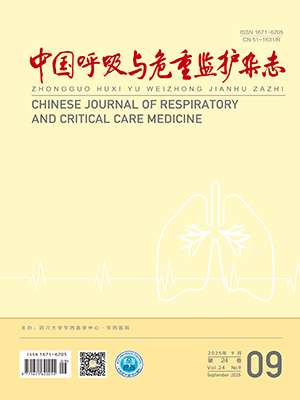| 1. |
范帅华, 杜鹏程, 郭军. 纳米孔测序技术在呼吸系统感染病原学诊断中的应用价值与展望. 中华医学杂志, 2021, 101(25): 2013-2015.
|
| 2. |
金美花. 侵袭性真菌感染诊断的三种方法研究. 中国民康医学, 2014, 26(11): 23-25.
|
| 3. |
宋利琼, 李金明. 呼吸道病毒检测方法的研究进展. 国际病毒学杂志, 2012, 19(1): 30-33.
|
| 4. |
孙敬, 陈会, 余理智, 等. 痰液培养定植菌与病原菌判断方法的探讨. 江西医学检验, 2006, 24(6): 485-488.
|
| 5. |
宏基因组分析和诊断技术在急危重症感染应用专家共识组. 宏基因组分析和诊断技术在急危重症感染应用的专家共识. 中华急诊医学杂志, 2019, 28(2): 151-155.
|
| 6. |
中华医学会检验医学分会. 高通量宏基因组测序技术检测病原微生物的临床应用规范化专家共识. 中华检验医学杂志, 2020, 43(12): 1181-1195.
|
| 7. |
中华医学会呼吸病学分会呼吸危重症医学学组, 中国医师协会呼吸医师分会危重症医学工作委员会. ICU患者支气管肺泡灌洗液采集、送检、检测及结果解读规范. 中华结核和呼吸杂志, 2020, 43(9): 744-756.
|
| 8. |
张彬, 张弦, 赵华, 等. 宏基因组学二代测序在不明原因发热患者病原体检测中的应用. 交通医学, 2020, 34(2): 131-135.
|
| 9. |
陈涔, 李园园, 潘频华, 等. 二代测序技术在重症社区获得性肺炎诊断中的意义. 中国感染控制杂志, 2020, 19(4): 335-340.
|
| 10. |
王艳泓, 邱玉英, 唐健, 等. 结合宏基因组二代测序诊断的八例鹦鹉热患者临床分析. 中国呼吸与危重监护杂志, 2021, 20(7): 472-478.
|
| 11. |
郑祎, 王辉. 艾滋病合并马尔尼菲篮状菌感染的诊治临床研究进展. 新发传染病电子杂志, 2021, 6(2): 151.
|
| 12. |
冯学威, 李胜岐, 郭津津, 等. 三种疱疹病毒感染与慢性阻塞性肺疾病的关系. 中华结核和呼吸杂志, 2003, 26(12): 805.
|
| 13. |
杨俊玲, 赵凤莲, 张焕英. 406 例呼吸道感染患者血清呼吸道病毒 IgM 抗体检测结果分析. 临床内科杂志, 2010, 27(3): 196-197.
|
| 14. |
Lanks CW, Musani AI, Hsia DW. Community-acquired Pneumonia and Hospital-acquired Pneumonia. Med Clin North Am, 2019, 103(3): 487-501.
|
| 15. |
Zhuang QD, Ma HY, Zhang Y, et al. Galactomannan in bronchoalveolar lavage fluid for diagnosis of invasive pulmonary aspergillosis with nonneutropenic patients. Can Respir J, 2017, 2017: 3685261.
|
| 16. |
Li H, Gao H, Meng H, et al. Detection of pulmonary infectious pathogens from lung biopsy tissues by metagenomic next-generation sequencing. Front Cell Infect Microbiol, 2018, 8: 205.
|
| 17. |
余伟鹏, 冼美兰, 黄奕荣. 医院获得性肺炎多重耐药菌感染的易感因素及耐药性分析. 中国现代医学杂志, 2017, 27(5): 125-129.
|
| 18. |
施裕新, 张志勇, 朱莹. 重视免疫抑制性肺真菌病的影像诊断. 放射学实践, 2012, 27(9): 930-931.
|
| 19. |
杨郝亮, 郭楠, 李宝萍, 等. 908 例呼吸道感染患者病原体的 IgM 抗体检测结果分析. 标记免疫分析与临床, 2017, 24(11): 1212-1215.
|
| 20. |
宁雅婷, 杨启文, 陈新飞, 等. 临床微生物快速检测新技术发展现状与前景. 协和医学杂志, 2021, 12(4): 427-432.
|
| 21. |
周永召, 李亚伦, 范红, 等. 临床宏基因组学在呼吸感染性疾病精准诊疗中的疑问解析. 中国呼吸与危重监护杂志, 2018, 17(6): 539-543.
|




